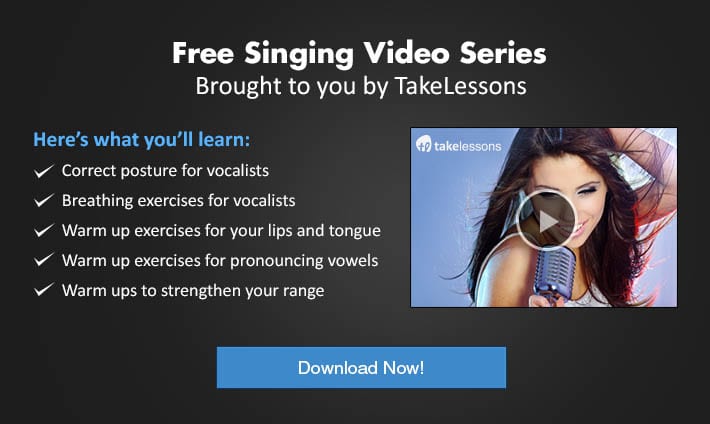There are so many different styles and genres to learn to sing, from classical singing to jazz. Read on for some tips from vocal coach Heather L. about exploring pop music, even if you started out with classical training…
This article, however instructional, is a very personal one for me to write. After studying opera and classical singing exclusively for 10 years, I finally admitted to myself that while I still loved to sing, I no longer loved to sing in that style. And while that part of my journey gave me the knowledge and confidence to find my life’s work, teaching music, I wanted to return to the kind of music that inspired me to start singing in the first place: pop.
Here is the story of a similar singer who gained experience switching between classical and pop singing. Note the differences she mentions between the two styles, and then continue reading below for some helpful tips to begin transitioning from classical to pop.
As my longest and most impactful voice teacher once told me, the biggest difference between classical music and pop is that in classical music, the music is more important than the words, and in pop, the words are more important than the music. Understanding this notion has helped me greatly in my own path from the world where the most gorgeous aria could be about a tree, to the world where a simple, unfulfilling melody is matched with profound lyrics about civil rights. This is an important principle that could begin your process of transition. Here are the rest of the steps.
• Start listening to a lot of (quality) pop
You’ve really got to feed yourself with pop music is order to familiarize yourself with the style. Many classical singers who’ve crossed over to pop are critiqued, as the results are sometimes unsuccessful. They sound silly because the singer, however fantastic and admired in his original genre, never really “got” the elements of the style — the dips, the scoops, the combination of straight tone and vibrato. These are best learned through lots of listening — but be careful not to mimic, and try out many different, quality pop singers, preferably recorded before auto-tuning took over pop. Try early Mariah Carey, early Whitney Houston, early Sinead O’Connor, Boyz II Men, former musical theater singer Adam Lambert, folk singer-songwriter Shawn Colvin, and maybe the finest example of a non-classical voice, Eva Cassidy. Perhaps the clearest way to hear a truly non-computerized voice is live, indie concerts or open mics, or indie folk albums. By listening to non-classical music sung without tons of filtering and mastering, you’ll get a sense of what a pure voice sounds like in a pop context.
• Loosen up
I mean this literally and figuratively. Classical singing may require the most free and unencumbered musculature and mentality, but pop music by its very nature will ask you to tighten up. Contrary to popular perception, classical singers are the most open and tension-less, and often pop is the most controlled and constructed, so to speak. That means that you should be prepared by being extra stretched and loose. Pop singing also calls for a loose approach to what voice teachers and classically trained singers call “placement.” How your registers feel and sound will change as you transition to pop, so be open.
• Get quick
As a classical singer, you may or may not have specialized in singing especially fast musical passages sung on a single syllable, known as melismatic singing. And you could very well sing pop music without learning it. But with it, you can gain so much more versatility as an artist. Often in pop music, we hear it in what are called “runs,” most often in descending scales and usually at the end of a line or major section. The best place to learn melismatic singing for pop is the gospel world. Listen to Mahalia Jackson and Yolanda Adams to get a feel for it.
• Learn about belting and floating
In pop singing, we often have a choice between belting our high notes, and floating them in what I call “faux falsetto,” an intentionally weak sound. This latter option is probably not how you are used to approaching high notes as a classical singer. We may be taught to “float” as a means to let go of tension, but in pop singing, I have long suspected that this light, weak, and feathery sound is used either to establish a sense of vulnerability or to create a sense that the note is so utterly high that the listener should be impressed. Either way, it’s an essential stylistic tool. Belting is another element altogether. It’s really a way to sing and yell at the same time. In my professional opinion, it should only be put into your regular bag of singing tricks under the guidance of a teacher who specializes in musical theater or Broadway singing. The bottom line is that singers aren’t forced to choose one over the other all the time. Belting can be used during heavily emotional and empowered moments, while floating, or the faux falsetto, can be used during a tender and brokenhearted moment.
• Start practicing your English
Okay, so for most of you, English is your first language. But for many of us, English was not the only, or even primary, language that we studied in our voice literature. I think English is a wondrous and fun language, but it’s not exactly the most conducive to classical singing. It’s cumbersome, feeling almost chunky in the mouth. Italian, on the other hand, is rolling and fluid as it falls out. Singing pop music in English is all about being a little conversational and a lot more intimate sounding. Conversational diction — and not “Mary Poppins diction” — is a major part of what makes a pop singer sound like a genuine pop singer.
My final suggestion is to have a lot of fun. This transition from classical singing to pop singing may get frustrating at times, but just remember that you already are a singer. You’re not starting from scratch. You’re simply taking a slight bend in a long and winding road.
Continue learning: Check out our Ultimate Guide to Singing Styles and Genres!
 Heather L. teaches singing, piano, acting, and more in St. Augustine, FL, as well as through online lessons. She is a graduate of the prestigious Westminster Choir College in Princeton, New Jersey, and has performed with the New York and Royal Philharmonics, the New Jersey and Virginia Symphonies, the American Boy Choir, and the internationally renowned opera star Andrea Bocelli. Learn more about Heather here!
Heather L. teaches singing, piano, acting, and more in St. Augustine, FL, as well as through online lessons. She is a graduate of the prestigious Westminster Choir College in Princeton, New Jersey, and has performed with the New York and Royal Philharmonics, the New Jersey and Virginia Symphonies, the American Boy Choir, and the internationally renowned opera star Andrea Bocelli. Learn more about Heather here!
Photo by Adam Haranghy
Suzy S.


